| Top of Page
Catapults
and Elastic energy conversion in fleas and archery - from FT Exploring |
| |
 |
|
How
fleas, catapults, and some other devices and animals, use energy storage
mechanisms to improve performance. |
|

A poorly thought out
demo of this page's subject. |
 |
 |
 |
 |
 |
 |
|
|


|
If this page is helpful, please share it:
|

|
 |
 |
 |
 |
 |
 |
|
|
| |
The
Flea, the Catapult, and the Bow - Part 2
Wherin we see that human inventions do oft seem to copy nature
- sometimes
The Energy
Comes from the Muscles
In Part 1
of "The Flea, the Catapult, and the Bow",
we introduced the fascinating notion that fleas and humans use the same basic
principles to hurl themselves (in the case of fleas) or objects (in the case of
stones and arrows) through the air much higher (in the case of the fleas) or faster
(in the case of the stones and arrows) than their own muscles could fling them.
In this section, we will explain in a little more detail how they do it. Remember
that the whole point is to get going as fast as possible in a short distance.
Muscles can't always go as fast as we would like them to, but they still have
to provide the energy. The bow, the catapult, and the flea's resilin store that
muscle energy then release it much faster than the muscles could.
The
Mysterious Everything is Still Flowing
Remember that everything that happens in this world happens because there has
been a change of energy from one form to another. Archery practice and flea jumps
are just continuations of the energy flows described in the Life
Flows and Sunshine to Sugar
sections.
Click here to continue on
down to Part 2 of Fleas and Catapults...
Or just keep scrolling down...
|
|
 |
|
| |
|
Selected
by the SciLinks program, a service of National Science Teachers Association. Copyright
2001
|
|
| |
|
Back to Part 1
Flying Turtle Home
Mysterious Everything
Ask Dr. Galapagos
Energy Intro Page
Photosynthesis & Energy
Thank an Engineer
Energy Changes
Heat Flowing
Contact
Me
Privacy Statement
Copyright |
|
| |
|
|
Written
by David Watson
Comments, Suggestions, Questions |
|
 |
 |
 |
 |
 |
|
|
| |
 |
Spacing |
 |

| |
|
|
| |
How
a Bow Transforms Energy
1.
Bow Drawn - Energy Stored
Look at the drawing on the
right. In position 1, the bow is drawn, just like in both drawings above. The
person who drew the bow, used his or her muscles to bend the bow by pulling back
on the arrow and the string. All of the energy that the person used to pull the
string back is now stored in the elastic material of the bow. Energy stored like
this is called potential energy. The bow is made
of elastic "springy" material that is
good at storing and releasing energy.
2. Arrow
Released - Energy Transferred to Arrow
In position 2, the archer
has let go of the string. The bow, because it is made of elastic material,
has "sprung" back to its original shape. When
the bow springs back it straightens the string which pushes the arrow forward
very fast. Almost all of the muscle energy that was stored in the bow is transferred
(very quickly) to the arrow.
|
|
| |
|
|
 |
 |
 |
From
a middle ages safety pamphlet on improper maintenance practices:

| |
 |
 |
 |
| |
The Science of Elastic Energy Storage |
|
 |
 |
 |
| |
|
|
|
| |
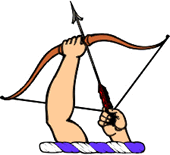 |
|
"I
shot an arrow into the air,
It fell to earth I knew not where."
Henry Wadsworth Longfellow,
apparantly discussing the mysteries of ballistics and energy conversion. |
 |
 |
 |
 |
Converting
Muscle Power into a Speeding Arrow
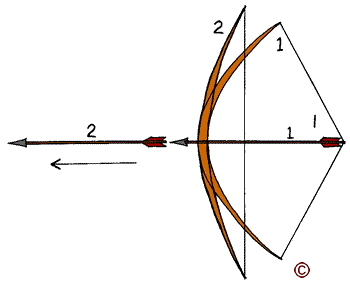 |
| |
It's Got To Be Elastic
Bows must be made of "elastic" material.
Elastic materials are good at storing and releasing energy. Steel and rubber are
both very elastic. Steel can be made into springs, and everyone knows what you
can do with a rubber band.
Some of the more elastic materials found in nature include tendon, horn, resilin,
and many types of wood.
 The
famous english longbows were usually made of wood from Spanish yew-trees. Bows
around the Mediterranean were sometimes made of horn, wood, and tendon combined
in layers. These composite bows had wood in the middle, tendon on the outside
surface away from the archer, and horn on the inside surface facing the archer.
Yew is better in cool wet climates (like England), and tendon and horn are better
in warm dry climates. So it all worked out nicely. The
famous english longbows were usually made of wood from Spanish yew-trees. Bows
around the Mediterranean were sometimes made of horn, wood, and tendon combined
in layers. These composite bows had wood in the middle, tendon on the outside
surface away from the archer, and horn on the inside surface facing the archer.
Yew is better in cool wet climates (like England), and tendon and horn are better
in warm dry climates. So it all worked out nicely.
|
|
| |
Important Safety Tip Quiz:
Every archer
knows you must never never pull back and release a bow without an arrow in it.
This can damage the bow and possibly injure the archer. Why?
|
|
 |
 |
 |
|
|
| |
 |
| |
 |
| |
How
a Flea Changes Muscle Energy into a High Speed Jump
|
|
| |
1. In the first drawing the flea's leg is "cocked". The flea uses his leg
muscles to bend the femur up against the coxa. Inside the coxa is
a pad of resilin. The elastic resilin stores the
muscle energy just like the bow stores human muscle energy.
A trigger device in the leg keeps the leg bent. Otherwise the flea would have
to use its muscles to keep the leg bent. |
|
| |
|
|
| |
2. In the second drawing, the flea has released the trigger and the resilin pad,
like a spring, has released its energy which pushes the leg open very fast.
Resilin is very efficient. Almost all of the muscle energy that was stored is
converted to jumping energy. Energy of motion or velocity is sometimes called kinetic energy.
|
|
| |
|
|
| |
3. Lift Off! The resilin "spring" throws the flea into the air at
a much higher speed than would be possible if the leg muscles were used for jumping. Potential energy has been turned into kinetic
energy.
Some fleas are able to jump over a hundred times their body length. This is not
bad for such a small animal, but is really just a mediocre jump. It is in no way
equivalent to a human jumping 100 times its body height. In fact we think horses
are far better jumpers than fleas. Something we will explore in another section. |
|
 |
 |
 |
|
|
Converting
Slow Muscle Energy to a High Speed Jump
 |
 |
 |
| |
1. Legs
Cocked - The flea stores muscle energy in a resilin pad inside the
coxa (looks kind of like a thigh). Resilin is an elastic (or "springy")
material. Resilin is one of the best materials known for storing and releasing
energy efficiently. |
|
 |
 |
 |
 |
 |
 |
| |
2. Pop Goes the Flea! The "springy" resilin pad releases the energy and opens the leg much
faster than the muscles can. The legs push the flea away from the ground and the
flea accelerates (speeds up) upward at a high
speed. |
|
 |
 |
 |
 |
 |
 |
| |
3. Lift off! The flea tumbles
several inches into the air. The resilin has changed muscle work into kinetic
energy (energy of motion).
|
|
 |
 |
 |
|
|
| |
The
catapults shown below were used by the Greeks and Romans. They were complicated
and required a lot of experimentation and skill to develop.
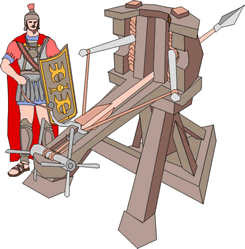
The
type of catapults shown here were very efficient. Almost all of the energy put
into the tendon springs was converted into the kinetic energy of the ball or spear.
The catapults below are shooting stones.
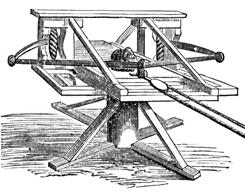
| |
|
|
| |
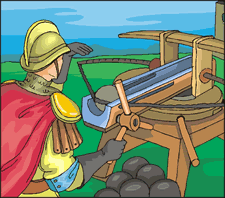 |
|
| |
|
|
| |
|
|
| |
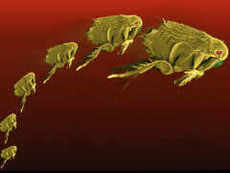 |
|
| |
A fidgity
flea "catapults" itself (literally) into the air without a catapult. |
|
| |
|
|
 |
 |
 |
Rubber is
an elastic material
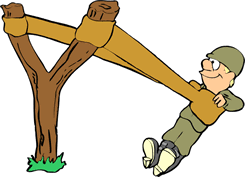 Warning:
Do not try this at home.
Warning:
Do not try this at home.
Contact
Me
|
|
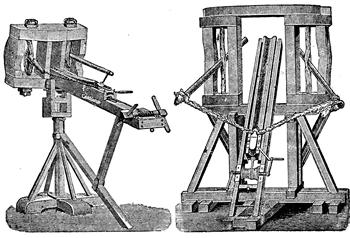
Sometimes
they threw big spears, sometimes they threw stones.
| |
How
a Catapult Changes Human Muscle Work into a Speeding Rock or Spear |
|
| |
The
catapult arms were stuck in an elastic material (usually the tendons of cows or
horses, but sometimes human hair was used). The elastic tendons were stretched
very tight. Two or more men had to work very hard to crank back the arms. |
|
 |
 |
 |
 |
 |
 |
| |
1. In position 1 above, almost
all of the hard work that the men had to do to pull back the arms is now stored
as potential energy in the tendon springs. The
arms are pulling very hard on the string which is stretched very tight. A locking
mechanism holds the string in place, just like in the flea. |
|
 |
 |
 |
 |
 |
 |
| |
2. In 2 above, the locking trigger has been released and the arms are being swung
around by the unwinding tendon springs. As they move forward they pull on the
string. The string pushes on the stone ball, accelerating it greatly. |
|
 |
 |
 |
 |
 |
 |
| |
3. Now the string is straight, the arms have stopped moving, and all the energy that
was stored in the tendon springs has been transferred into the projectile (big
word for rock or bullet or arrow or whatever). The rock leaves the catapult at
a very high velocity. |
|
 |
 |
 |
 |
 |
 |
| |
Same
Important Safety Tip:
Releasing a catapult without a projectile in it was extremely
dangerous. The catapult could fly apart, seriously injuring or even killing the
operators.
What's going on with that? |
|
 |
 |
 |
|
|
| |
|
|
|
 |
 |
 |
| |
If this page was helpful, please recommend it:
|
|
 |
 |
 |
 |
 |
|
|
| |
|
Definitions
|
|
|
| |
|
Kinetic Energy - The energy
of motion. All objects that are moving have kinetic energy. When a baseball is
flying through the air, the energy that determined how fast it is going is kinetic
energy. The faster the ball travels the more kinetic energy it has.
As the ball moves through the air it is slowed down by
air resistance. The ball has to push the air molecules out of the way. This air
resistance slows the ball down as it travels. As it slows down its kinetic energy
gets smaller also. Some of the ball's kinetic energy is being transferred to billions
and billions of air molecules.
When the ball hits the ground, much of the rest of the
kinetic energy is transferred into the ground as heat. Some of the energy is used
to move the dirt or grass out of the way. Some of the energy is used to smash
the ball a little and the ground a little. The ball and the ground have a little
elasticity so the ball might bounce a few times.
When a ball bounces, the kinetic energy is stored for a moment
in the squashed ball, then the ball springs back and the energy is turned back
into kinetic energy. This can happen over and over, but eventually all of the
kinetic energy is turned by friction into heat in the ground and the ball, until
the ball finally stops. When the ball stops completely, that means all of the
kinetic energy has been turned into heat. Really, all of the energy has been turned
into heat. Though the change is too small to be measured, the air, the ball, and
the ground, are actually a little warmer because all of the kinetic energy has
heated them up.
Kinetic Energy is just another one of the Mysterious
Everything's personalities.
|
|
|
 |
 |
 |
 |
 |
| |
|
Potential
Energy - Potential
Energy is kind of like energy that is ready or waiting or willing to happen. (I
must now ask forgiveness from all the physics and mechanical engineering professors
for proceeding without formulas or math). Examples are helpful when trying to
avoid formulas and numbers, so here come some examples.
When you stretch and hold a rubber band, the energy your
muscles exerted to stretch it, is now being stored in the deformed rubber band
(as long as you keep it stretched). The Potential Energy stored in the rubber
band is exactly equal to the amount of energy used to stretch it. If you shoot
the rubber band off your finger, making sure to aim away from people's eyes, almost
all of the potential energy that was stored in the rubber band is turned into
the kinetic energy (see above) of the rubber band flying through the air.
Pick up a stone and lift it over your head (not a very
big stone please). It takes energy to lift the stone. Your muscles have to push
the stone up against the force of gravity. The force of gravity is trying to pull
it back down to the ground. As long as you hold the stone over your head the stone
is storing the energy you exerted to lift it, as gravitational potential energy.
If you let it fall back to earth, the potential energy you put into the stone
with your muscles will be converted into kinetic energy as it falls (except for
a little bit of energy that is used to push air molecules out of the way). All
of the kinetic energy, that was formerly potential energy, is turned into heat
when the rock smacks into the ground. Really, it all turns into heat. The ground
and the rock, and even the air a little bit, get a tiny bit warmer.
|
|
|
 |
 |
 |
 |
 |
| |
|
Acceleration
- This is a big word for speeding
up or increasing speed. When you are in a car starting up from a stop light, with
your gas pedal shoved down, your car is accelerating forward (unless you have
a really wimpy engine - then it might be stalling). You feel yourself being pushed
into the seat back. You look down at the speedometer and see that the needle is
moving to higher and higher numbers. No it's not the twilight zone, it's just
the ordinary mysterious world we live in. You probably don't think about it often
(or ever) but when you press down on the gas pedal you are converting the chemical
energy stored in the gasoline (energy which came from the sun originally and was
put there by photosynthesis a long time
ago) into power which is being used to push the car forward at a faster and faster
speed.
As long as the car keeps going faster and faster
it is accelerating. When it reaches the speed you want to go, you ease up on the
gas pedal and try to keep the car at a constant velocity (see the next definition
down). When speed is constant or unchanging, there is no acceleration. Speed is
constant and acceleration is zero.
In order to accelerate an object, a force is required.
Your body is accelerated by the pushing force of the car seat on your back. The
car is pushed forward by the force of the tires on the road. The tires are turned
by the turning force (torque) of the transmission through a bunch of gears onto
the axle. The transmission is turned by the turning force of the crankshaft in
the engine. The crankshaft is turned by the force of the connecting rods pushing
down. The connecting rods are pushed down by the pistons. The pistons are pushed
down by the force of the burning gasoline and air expanding in the cylinders.
"Whole lot of pushing going on."
|
|
|
 |
 |
 |
 |
 |
| |
|
Velocity
- As most of
us laypersons use it, this is another word for speed (vector stuff below). Speed
is measured or described by how far an object travels in a certain amount of time.
When a car is traveling 60 miles per hour that means that if the car keeps moving
at that speed for one hour it will travel 60 miles. It also means that the car
travels 88 feet every second or 88 feet per second or 88 feet/second. If the car
is speeding up (going faster and faster) then it is accelerating. If the car is
slowing down it is decelerating. If the velocity is constant than there is no
acceleration. An engineer would say the acceleration is zero, because engineers
always put numbers on things.
One more thing about
velocity (for the more advanced students):
To be more correct, and to please the physicists
in our "audience", I must add that velocity is more correctly defined
as a vector quantity. That means that to completely and correctly describe velocity
you have to define a direction for it as well as a speed. This is done mathmatically
and graphically with a vector diagram. A line with an arrow at one end is how
this is usually shown. The angle of the line compared to some reference line(s)
gives the direction relative to other vectors. The length of the line is proportional
to the speed in units like meters per second, or kilometers per hour. And then
there are some fun vector math and vector calculus techniques to do the "figuring",
but alas not covered here.
|
|
|
 |
 |
 |
 |
 |
| |
|
Elastic
- See Definition
Above
|
|
|
 |
 |
 |
 |
 |
| |
|
If this page was helpful, please recommend it:
|
|
|
| |
|
|
 |
|
| |
|
|
 |
|
 |
 |
 |
 |
 |
|
|


|
©Copyright 2014. David
Watson. All rights reserved. Almost everything in the Flying Turtle web site is
copyrighted, including all graphics, pictures, text, html code, sound, and layout.
For information concerning use of this material, click on the word Copyright.
|
|
|
|
| |
|
|
 |
 |
 |







